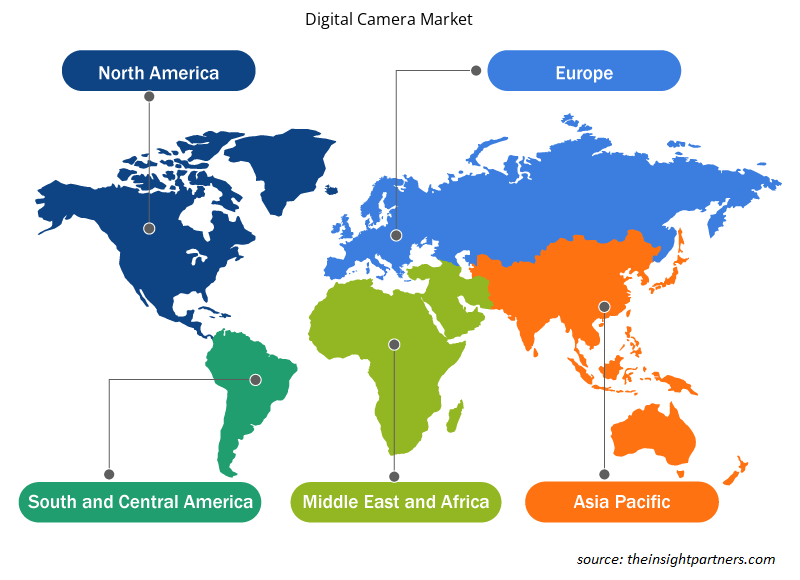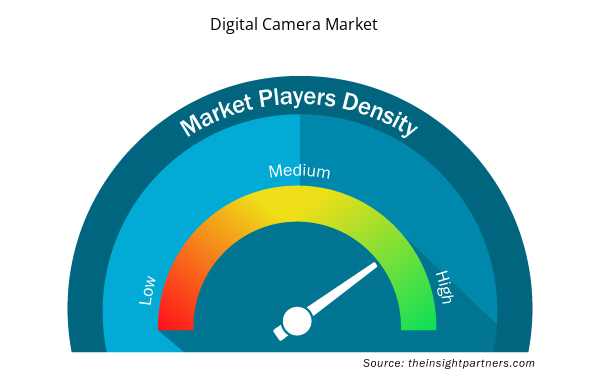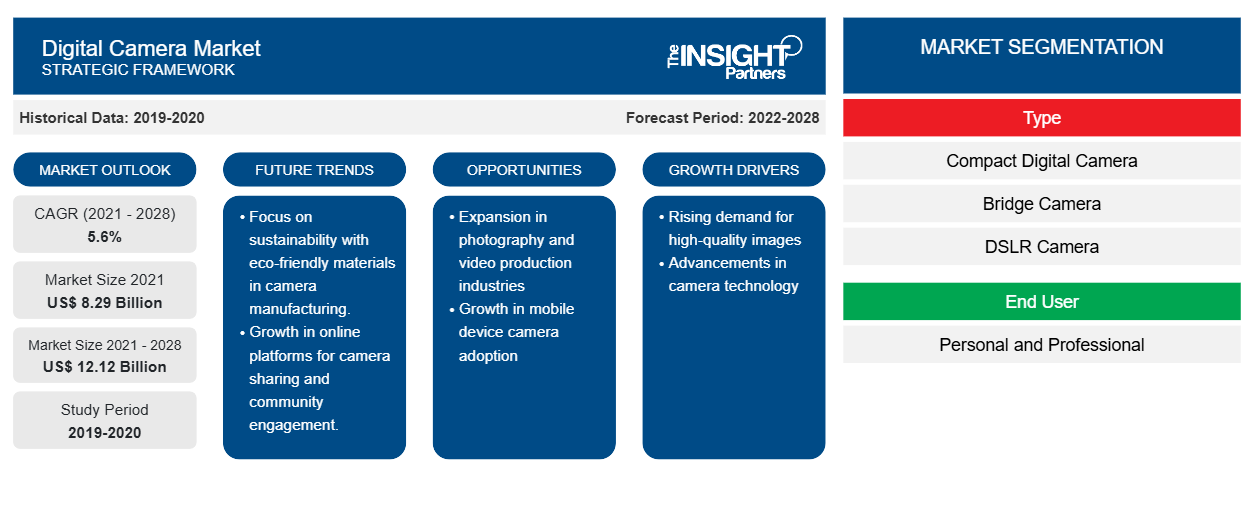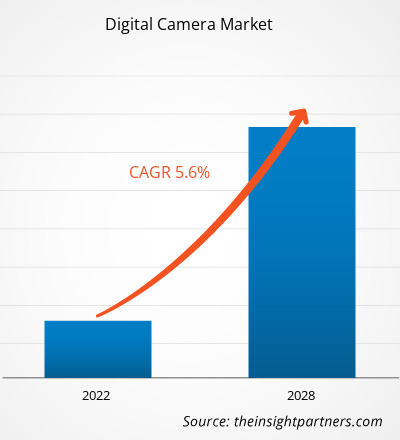デジタルカメラ市場は、2021年の82億9,025万米ドルから2028年には121億1,944万米ドルに成長すると予想されており、2021年から2028年にかけて5.6%のCAGRで成長すると予測されています。
デジタルカメラの使用は、個人やプロの写真撮影に限定されず、エンターテインメント、メディア、スポーツ業界全体に広がっています。映画業界は、世界のエンターテインメント業界の中で最大かつ最も収益性の高いカテゴリの1つです。たとえば、中国の映画業界は世界最大の映画産業の1つであり、2016年には約66億米ドルの収益を上げています。映画とエンターテインメント業界のこの有望な見通しは、完璧なショットやビデオを実現するためのデジタルカメラの需要を促進すると予想されています。急速な技術の変化、消費者の行動、ビジネスモデルにより、消費者がエンターテインメントやメディアを体験し、支払う方法が変わりました。この業界のリーダーは、優れたコンテンツを制作するために、ファンに焦点を当てたビジネスとブランドの構築に注力しています。その結果、彼らはコンピューター生成画像(CGI)や視覚効果(VFX)などの技術と機器、および高度なカメラに多額の投資を行っています。
また、スポーツメディアではデジタルカメラが不可欠です。スタジアムに高速カメラやデジタルカメラを設置すると、観客は重要な試合場面でスローモーションのリプレイを見ることができるため、観戦中に正確さを得ることができます。同様に、野生動物、風景、建築、スタジオ撮影で高解像度のデジタルカメラを使用すると、鮮明で鮮明な画像や動画を撮影できます。アクション写真への注目が高まるにつれて、GoPro などのコンパクトデジタルカメラの需要が高まりました。さらに、Instagram などのソーシャル メディア プラットフォームによって写真撮影の範囲が大幅に拡大し、デジタルカメラ市場の成長が加速すると予想されています。
要件に合わせてレポートをカスタマイズする
このレポートの一部、国レベルの分析、Excelデータパックなど、あらゆるレポートを無料でカスタマイズできます。また、スタートアップや大学向けのお得なオファーや割引もご利用いただけます。
- このレポートの主要な市場動向を入手してください。この無料サンプルには、市場動向から見積もりや予測に至るまでのデータ分析が含まれます。
COVID-19パンデミックによる欧州デジタルカメラ市場への影響:
コロナウイルスのパンデミックは、ロックダウン、渡航禁止、事業停止により、さまざまな国の経済や産業に影響を及ぼしています。家電業界は、このパンデミックにより、サプライチェーンの崩壊、生産工場の閉鎖など、深刻な混乱に見舞われている主要産業の1つです。北米、ヨーロッパ、アジア太平洋、南米、中東、アフリカなどの主要地域のさまざまな製造工場や工場の閉鎖は、世界のサプライチェーンに影響を及ぼし、さまざまな商品の製造、配送スケジュール、販売に悪影響を及ぼしています。さらに、さまざまな企業がすでに製品の配送の遅れや製品の将来の販売の低迷の可能性を発表しています。これに加えて、ヨーロッパ、アジア、北米の国々が課した世界的な渡航禁止は、ビジネスコラボレーションやパートナーシップの機会に影響を与えています。これらすべての要因が家電業界に悪影響を及ぼし、今後数か月間、この業界に関連するさまざまな市場の成長を抑制する要因になると予想されます。デジタルカメラの市場は、生産不足と輸送施設の制限により、パンデミックの影響を受けています。
デジタルカメラ市場の洞察
デジタルカメラに関連する技術革新がデジタルカメラ市場の成長を促進
デジタルカメラ市場の枠組みは、HDやタッチスクリーンなどの革新的な技術開発と強力な進歩に支えられた新たな急進的なトレンドと密接に関連しています。 消費者の高度な写真撮影への傾向が高まっているため、市場では長い間、デジタル一眼レフカメラとSLRカメラ市場の需要が高まっています。 しかし、技術の進歩により、12〜20メガピクセルを提供する高解像度カメラが開発されました。 デジタルカメラの分野における継続的な進化により、解像度が向上し、フォーカスが速く、さまざまな周辺機器をサポートする高度なカメラが設計されました。 また、スマートフォンに対する競争上の優位性を提供するために、デジタルカメラにWi-Fiまたは4Gモデムを組み込む傾向の増加も観察されています。 さらに、このようなカメラは、近い将来、スマートフォンやスピーカーアシスタントなどの他の相互接続されたデバイスとの効果的な通信を可能にするIoT(モノのインターネット)などのいくつかの相互接続されたデバイスの一部になると予想されています。
タイプベースの市場分析
デジタルカメラ市場は、種類別に、コンパクトデジタルカメラ、ブリッジカメラ、DSLRカメラ、ミラーレスカメラ、デジタルレンジファインダーカメラ、ラインスキャンカメラに分類されます。2020年には、DSLRカメラセグメントが市場で最大のシェアを占めました。
デジタルカメラ市場の地域別分析
予測期間を通じてデジタル カメラ市場に影響を与える地域的な傾向と要因は、Insight Partners のアナリストによって徹底的に説明されています。このセクションでは、北米、ヨーロッパ、アジア太平洋、中東およびアフリカ、南米および中米にわたるデジタル カメラ市場のセグメントと地理についても説明します。

- デジタルカメラ市場の地域別データを入手
デジタルカメラ市場レポートの範囲
| レポート属性 | 詳細 |
|---|---|
| 2021年の市場規模 | 82億9000万米ドル |
| 2028年までの市場規模 | 121.2億米ドル |
| 世界のCAGR(2021年~2028年) | 5.6% |
| 履歴データ | 2019-2020 |
| 予測期間 | 2022-2028 |
| 対象セグメント | タイプ別
|
| 対象地域と国 | 北米
|
| 市場リーダーと主要企業プロフィール |
|
市場プレーヤーの密度:ビジネスダイナミクスへの影響を理解する
デジタル カメラ市場は、消費者の嗜好の変化、技術の進歩、製品の利点に対する認識の高まりなどの要因により、エンド ユーザーの需要が高まり、急速に成長しています。需要が高まるにつれて、企業は提供内容を拡大し、消費者のニーズを満たすために革新を起こし、新たなトレンドを活用し、市場の成長をさらに促進しています。
市場プレーヤー密度とは、特定の市場または業界内で活動している企業または会社の分布を指します。これは、特定の市場スペースに、その市場規模または総市場価値に対してどれだけの競合相手 (市場プレーヤー) が存在するかを示します。
デジタルカメラ市場で事業を展開している主要企業は次のとおりです。
- キヤノン株式会社
- イーストマン・コダック社(JKイメージング社)
- 富士フイルムホールディングス株式会社
- ライカカメラAG
- 株式会社ニコン
免責事項:上記の企業は、特定の順序でランク付けされていません。

- デジタルカメラ市場のトップキープレーヤーの概要を入手
エンドユーザーベースの市場分析
デジタルカメラ市場は、用途に基づいて個人用とプロ用に分かれています。2020年には、プロ用セグメントが大きな市場シェアを占めました。
デジタル市場で活動するプレーヤーは、市場での地位を維持するために、合併、買収、市場イニシアチブなどの戦略を採用しています。主要プレーヤーによるいくつかの開発を以下に示します。
- 富士フイルムホールディングス株式会社は、ミラーレスデジタルカメラ「GFXシリーズ」の最新作となる「FUJIFILM GFX100S」を2021年2月下旬に発売すると発表しました。
- ニコン株式会社は、フルサイズミラーレスカメラ「Z 7II」を発売しました。「Z 7II」は、フルサイズで高画質なミラーレスカメラです。このような製品の発売を通じて、当社は映像文化の発展に貢献してまいります。
デジタルカメラ市場は以下のように分類されています。
タイプ別
- コンパクトデジタルカメラ
- ブリッジカメラ
- デジタル一眼レフカメラ
- ミラーレスカメラ
- デジタルレンジファインダーカメラ
- ラインスキャンカメラ
エンドユーザー別
- 個人的
- プロ
地理別
北米
- 私たち
- カナダ
- メキシコ
ヨーロッパ
- フランス
- ドイツ
- イタリア
- 英国
- ロシア
- その他のヨーロッパ
アジア太平洋(APAC)
- 中国
- インド
- 韓国
- 日本
- オーストラリア
- その他のアジア太平洋地域
中東・アフリカ(MEA)
- 南アフリカ
- サウジアラビア
- アラブ首長国連邦
- MEAの残り
南アメリカ(SAM)
- ブラジル
- アルゼンチン
- 残りのSAM
企業プロフィール
- キヤノン株式会社
- イーストマン・コダック社
- 富士フイルムホールディングス株式会社
- ライカカメラAG
- 株式会社ニコン
- オムデジタルソリューションズ株式会社
- パナソニック株式会社
- ハッセルブラッド
- リコーイメージング株式会社
- ソニー株式会社
- 過去2年間の分析、基準年、CAGRによる予測(7年間)
- PEST分析とSWOT分析
- 市場規模価値/数量 - 世界、地域、国
- 業界と競争環境
- Excel データセット



Report Coverage
Revenue forecast, Company Analysis, Industry landscape, Growth factors, and Trends

Segment Covered
This text is related
to segments covered.

Regional Scope
North America, Europe, Asia Pacific, Middle East & Africa, South & Central America

Country Scope
This text is related
to country scope.
よくある質問
DSLR cameras held the largest share in 2020 and they are the most versatile, high-end, and advanced type cameras. These cameras use single-lens reflex method. They consist of a mirror, which reflects the light passing through the lens. DSLR cameras are mostly large in size. These cameras are mainly used by professional photographers or videographers for commercial purposes. Automatic mode and changeable camera lens to fit different situations are the important feature of DSLR cameras. However, DSLR camera manufacturers are now focusing on integrating software enhancements and other technologies in these cameras for enhanced consumer experience, this factor is expected to drive the demand in the coming years.
With the growing trend toward photography, the demand for digital cameras is expanding. Digital camera allows to capture and store photos and videos digitally rather than printing it to film as per traditional analog cameras. As the consumers are becoming enthusiastic toward sight capturing, the demand for compact, lightweight, and high-quality cameras is rising. Further, the introduction of digital cameras and smartphones has created photography a mainstream profession, which have subsequently generated the need for high quality cameras with user-friendly interface and affordable price.
Mirrorless cameras are expected to drive the future growth of digital camera market. A mirrorless system camera does not involve a mirror box within its body and are designed with a compact and attractive exterior with an electronic viewfinder paired with interchangeable lens. Such cameras offer convenience in use compared to digital SLR cameras owing to their smaller and lighter structure. Mirrorless camera comprises lens at the front body along with sensor placed inside and a screen along with an optional viewfinder placed at the back. Additionally, such cameras have small, short, and light lenses and are constructed with a tiny LED or OLED screen, which helps to deliver best possible results altogether. Hence, the expanding demand for mirrorless cameras is expected to create lucrative opportunities for the growth of the digital cameras market.
Trends and growth analysis reports related to Electronics and Semiconductor : READ MORE..
The List of Companies - Digital Camera Market
- Canon Inc.
- Eastman Kodak Company (JK Imaging Ltd.)
- Fujifilm Holdings Corporation
- Leica Camera Ag
- Nikon Corporation
- Om Digital Solutions Corporation
- Panasonic Corporation
- Hasselblad
- Ricoh Imaging Company, Ltd
- Sony Corporation
The Insight Partners performs research in 4 major stages: Data Collection & Secondary Research, Primary Research, Data Analysis and Data Triangulation & Final Review.
- Data Collection and Secondary Research:
As a market research and consulting firm operating from a decade, we have published and advised several client across the globe. First step for any study will start with an assessment of currently available data and insights from existing reports. Further, historical and current market information is collected from Investor Presentations, Annual Reports, SEC Filings, etc., and other information related to company’s performance and market positioning are gathered from Paid Databases (Factiva, Hoovers, and Reuters) and various other publications available in public domain.
Several associations trade associates, technical forums, institutes, societies and organization are accessed to gain technical as well as market related insights through their publications such as research papers, blogs and press releases related to the studies are referred to get cues about the market. Further, white papers, journals, magazines, and other news articles published in last 3 years are scrutinized and analyzed to understand the current market trends.
- Primary Research:
The primarily interview analysis comprise of data obtained from industry participants interview and answers to survey questions gathered by in-house primary team.
For primary research, interviews are conducted with industry experts/CEOs/Marketing Managers/VPs/Subject Matter Experts from both demand and supply side to get a 360-degree view of the market. The primary team conducts several interviews based on the complexity of the markets to understand the various market trends and dynamics which makes research more credible and precise.
A typical research interview fulfils the following functions:
- Provides first-hand information on the market size, market trends, growth trends, competitive landscape, and outlook
- Validates and strengthens in-house secondary research findings
- Develops the analysis team’s expertise and market understanding
Primary research involves email interactions and telephone interviews for each market, category, segment, and sub-segment across geographies. The participants who typically take part in such a process include, but are not limited to:
- Industry participants: VPs, business development managers, market intelligence managers and national sales managers
- Outside experts: Valuation experts, research analysts and key opinion leaders specializing in the electronics and semiconductor industry.
Below is the breakup of our primary respondents by company, designation, and region:

Once we receive the confirmation from primary research sources or primary respondents, we finalize the base year market estimation and forecast the data as per the macroeconomic and microeconomic factors assessed during data collection.
- Data Analysis:
Once data is validated through both secondary as well as primary respondents, we finalize the market estimations by hypothesis formulation and factor analysis at regional and country level.
- Macro-Economic Factor Analysis:
We analyse macroeconomic indicators such the gross domestic product (GDP), increase in the demand for goods and services across industries, technological advancement, regional economic growth, governmental policies, the influence of COVID-19, PEST analysis, and other aspects. This analysis aids in setting benchmarks for various nations/regions and approximating market splits. Additionally, the general trend of the aforementioned components aid in determining the market's development possibilities.
- Country Level Data:
Various factors that are especially aligned to the country are taken into account to determine the market size for a certain area and country, including the presence of vendors, such as headquarters and offices, the country's GDP, demand patterns, and industry growth. To comprehend the market dynamics for the nation, a number of growth variables, inhibitors, application areas, and current market trends are researched. The aforementioned elements aid in determining the country's overall market's growth potential.
- Company Profile:
The “Table of Contents” is formulated by listing and analyzing more than 25 - 30 companies operating in the market ecosystem across geographies. However, we profile only 10 companies as a standard practice in our syndicate reports. These 10 companies comprise leading, emerging, and regional players. Nonetheless, our analysis is not restricted to the 10 listed companies, we also analyze other companies present in the market to develop a holistic view and understand the prevailing trends. The “Company Profiles” section in the report covers key facts, business description, products & services, financial information, SWOT analysis, and key developments. The financial information presented is extracted from the annual reports and official documents of the publicly listed companies. Upon collecting the information for the sections of respective companies, we verify them via various primary sources and then compile the data in respective company profiles. The company level information helps us in deriving the base number as well as in forecasting the market size.
- Developing Base Number:
Aggregation of sales statistics (2020-2022) and macro-economic factor, and other secondary and primary research insights are utilized to arrive at base number and related market shares for 2022. The data gaps are identified in this step and relevant market data is analyzed, collected from paid primary interviews or databases. On finalizing the base year market size, forecasts are developed on the basis of macro-economic, industry and market growth factors and company level analysis.
- Data Triangulation and Final Review:
The market findings and base year market size calculations are validated from supply as well as demand side. Demand side validations are based on macro-economic factor analysis and benchmarks for respective regions and countries. In case of supply side validations, revenues of major companies are estimated (in case not available) based on industry benchmark, approximate number of employees, product portfolio, and primary interviews revenues are gathered. Further revenue from target product/service segment is assessed to avoid overshooting of market statistics. In case of heavy deviations between supply and demand side values, all thes steps are repeated to achieve synchronization.
We follow an iterative model, wherein we share our research findings with Subject Matter Experts (SME’s) and Key Opinion Leaders (KOLs) until consensus view of the market is not formulated – this model negates any drastic deviation in the opinions of experts. Only validated and universally acceptable research findings are quoted in our reports.
We have important check points that we use to validate our research findings – which we call – data triangulation, where we validate the information, we generate from secondary sources with primary interviews and then we re-validate with our internal data bases and Subject matter experts. This comprehensive model enables us to deliver high quality, reliable data in shortest possible time.


 このレポートの無料サンプルを入手する
このレポートの無料サンプルを入手する